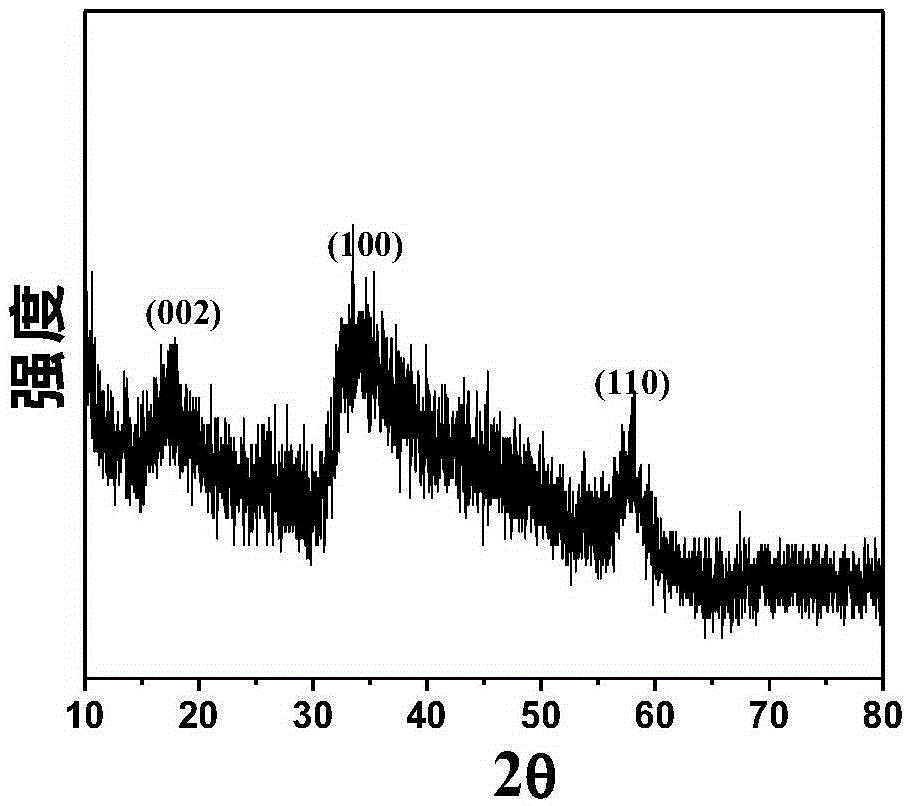Preparation method of flower-shaped molybdenum disulfide nano-rods
A technology of molybdenum disulfide and nanorods, which is applied in the field of nanomaterials, can solve the problems of complex process, high cost, and impact on large-scale application, and achieve the effects of high product yield, simple and easy-to-control production process, and low cost
- Summary
- Abstract
- Description
- Claims
- Application Information
AI Technical Summary
Problems solved by technology
Method used
Image
Examples
Embodiment 1
[0020] Dissolve 0.4g benzyltriethylammonium chloride and 0.42g Pluronic F-127 in 60mL of deionized water, then add 0.88g sodium molybdate, 1.40g sodium sulfide, and 0.6g glucose, after completely dissolving , and then adjust the pH value to about 6 with 2mol / L HCl; after stirring for 30min, transfer the mixture to a 100mL stainless steel reaction kettle, place it in a vacuum oven at 160°C for 24h, and cool to room temperature. After the reaction product was separated by centrifugation, it was washed repeatedly with deionized water and absolute ethanol, and finally dried at 60° C. for 12 hours under vacuum to obtain a gray-black powder product, namely molybdenum disulfide flower-like nanorods.
[0021] figure 1 The XRD pattern shows that the XRD peak position is consistent with the standard diffraction pattern (PDFNo.37-1492), and the product is a pure molybdenum disulfide nanostructure. figure 2 The SEM photo of the product shows the existence of a large number of flower-lik...
Embodiment 2
[0023] Dissolve 0.4 g of benzyltriethylammonium chloride and 0.63 g of Pluronic F-127 in 60 mL of deionized water, then add 0.88 g of sodium molybdate, 1.40 g of sodium sulfide and 0.6 g of glucose. After complete dissolution, adjust the pH value to about 6 with 2mol / L HCl; after stirring for 30 minutes, transfer the mixture to a 100mL stainless steel reaction kettle, place it in a vacuum drying oven at 180°C for 24 hours, and cool to room temperature; After the reaction product was separated by centrifugation, it was washed repeatedly with deionized water and absolute ethanol, and finally dried at 60° C. for 12 hours under vacuum to obtain a gray-black powder product, namely molybdenum disulfide flower-like nanorods. The obtained molybdenum disulfide flower-like nanorod has a diameter of 200-500 nm and a length of 1-2 μm.
Embodiment 3
[0025] Dissolve 0.4 g of benzyltriethylammonium chloride and 0.26 g of sodium dodecylbenzenesulfonate in 60 mL of deionized water, then add 0.88 g of sodium molybdate, 1.40 g of sodium sulfide, and 0.6 g of glucose. After completely dissolving, adjust the pH value to about 6 with 2mol / L HCl. After stirring for 30 minutes, transfer the mixture to a 100mL stainless steel reaction kettle, place it in a vacuum drying oven at 160°C for 24 hours, and cool to room temperature; after centrifugation, the reaction product is washed repeatedly with deionized water and absolute ethanol , and finally dried at 60° C. for 12 h under vacuum to obtain a gray-black powder product, namely molybdenum disulfide flower-like nanorods. The obtained molybdenum disulfide flower-like nanorod has a diameter of 200-500 nm and a length of 1-2 μm.
PUM
| Property | Measurement | Unit |
|---|---|---|
| diameter | aaaaa | aaaaa |
| length | aaaaa | aaaaa |
Abstract
Description
Claims
Application Information
 Login to View More
Login to View More - R&D
- Intellectual Property
- Life Sciences
- Materials
- Tech Scout
- Unparalleled Data Quality
- Higher Quality Content
- 60% Fewer Hallucinations
Browse by: Latest US Patents, China's latest patents, Technical Efficacy Thesaurus, Application Domain, Technology Topic, Popular Technical Reports.
© 2025 PatSnap. All rights reserved.Legal|Privacy policy|Modern Slavery Act Transparency Statement|Sitemap|About US| Contact US: help@patsnap.com



